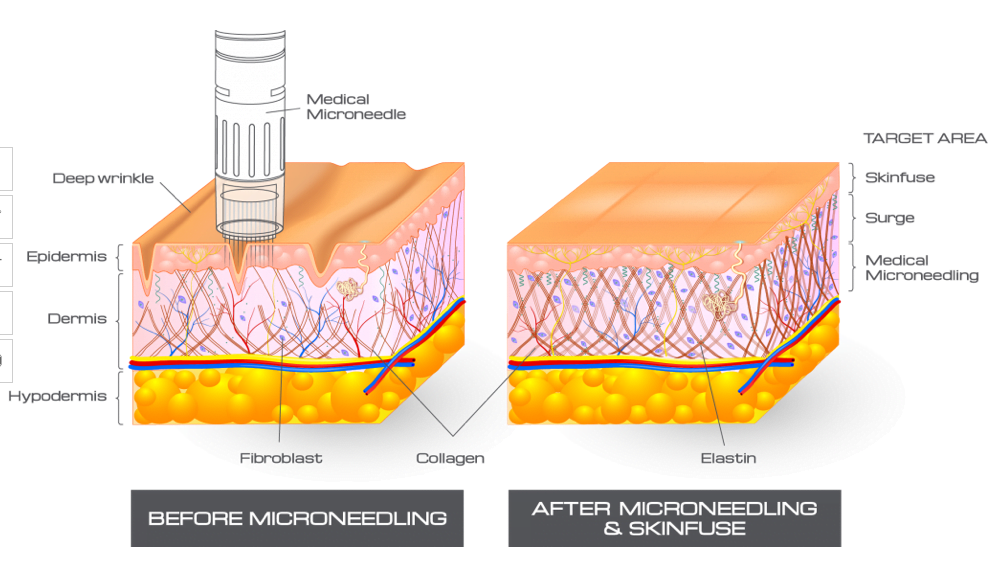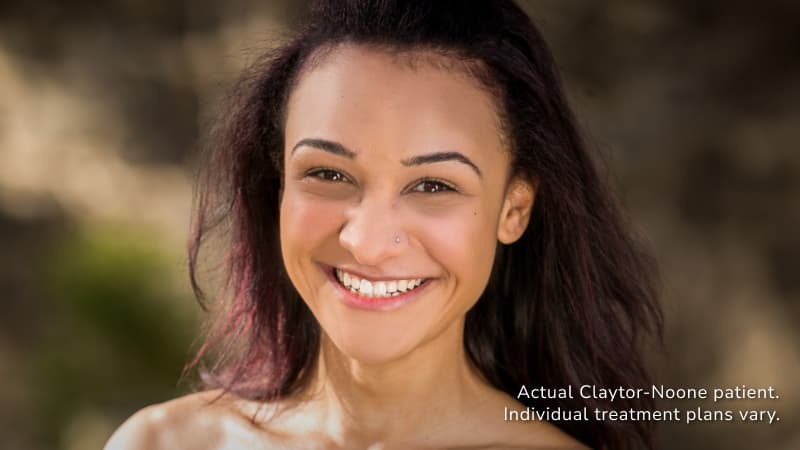Microneedling (Collagen Induction Therapy)
What is microneedling?
The body has amazing healing abilities. Microneedling at Claytor Noone Plastic Surgery puts those healing properties to work. Microneedling creates hundreds of microscopic punctures in the skin, which initiates a “wound healing” response in the body. The result is improved skin texture and firmness, decreased acne scarring, and reduction of large pores and visible stretch marks.
How does SkinPen microneedling work?
At Claytor Noone Plastic Surgery, we use the SkinPen for our microneedling. The SkinPen has 14 oscillating needles that can be set to different penetration depths, depending on the patient’s skin and the treatment site. Our Physician Assistant, Julie Holesh, performs our microneedling treatments and can adjust the penetration depth up to 2.5mm. She moves the SkinPen across the treatment area, and the pen’s 14 needles move up and down creating microscopic punctures through the epidermis(the skin’s outer layer) down into the dermis layer.
Exosomes + microneedling
For even more transformative results, we can apply a powerful topical exosome serum after microneedling. Exosomes are tiny vesicles that are secreted by cells, containing anti-inflammatory proteins and other molecules that help repair damaged tissue and stimulate new cell growth. Each dose contains two trillion exosome microvesicles.
Microneedling kickstarts your skin’s collagen production by creating tiny punctures, making it the perfect time to apply exosomes. Our specially formulated serum is enriched with amino acids and hyaluronic acid, penetrating deeply to promote healing and improve skin texture.
Shannon O’Brien, Medical Esthetician
Medical esthetician Shannon O’Brien has nearly 20 years of experience offering luxury medical spa services. Whether you need a relaxing facial or expert help with skin concerns like acne or wrinkles, she is here to help you achieve your best skin ever with treatments like chemical peels, microneedling, and laser skin resurfacing.
Will my skin heal quickly after microneedling?
The tiny punctures/channels begin to heal almost immediately, your body perceives the punctures as wounds and a wound-repair response is triggered. The body produces new collagen and elastin to send to the “wound” to heal it. Collagen is a protein responsible for the skin’s structural support, while elastin makes the skin firm, yet pliable.
Beyond triggering the wound response, the microscopic channels also make the skin more available to healing serums that can penetrate the skin far more effectively. This further improves the skin’s health and appearance.
Why collagen production is important
Collagen is the protein in our skin that provides its structural framework. When we’re young, the body is producing the most collagen; That’s why young skin is firm, plump, and resistant to the development of wrinkles. The problem is that our collagen and elastin production drops dramatically as we age. At the age of 20, our collagen production has peaked, and it will drop one additional percentage point every year from then on out. At 40, we’re producing 20 percent less collagen and 30 percent less at 50! That’s why older skin develops more wrinkles and creases, and why it begins to sag. Microneedling aims to jumpstart your collagen production.
What skin issues does microneedling improve?
At Claytor Noone Plastic Surgery, we use microneedling on all skin tones. It doesn’t cause hyperpigmentation and can be used anywhere on the body, face, neck, and décolletage are the typical targets. Here are skin conditions we treat with microneedling:
- Acne Scars
- Large Pores
- Fine lines
- Uneven texture
- Stretch marks
Traditionally, microneedling has been used to treat surgical scars starting about one year post-op, once scars have fully matured. In search of an improved treatment for his Philadelphia patients’ surgical scars, Dr. Claytor developed a technique for microneedling scars as early as 6-7 weeks after surgery, during the active scar maturation phase. He designed a research study to compare this technique’s effectiveness to methods for treating scars later and found that this early treatment led to improved aesthetic outcomes compared to treatments that were begun later in the healing process.
Dr. Claytor published this research in the journal Plastic and Reconstructive Surgery in 2023. His study was well-received by the plastic surgery community, and was awarded Honorable Mention for “Best Paper” by the journal.
Listen to this patient’s experience using microneedling to treat breast implant removal scarsVideo Transcript
Hi, I’m Dr. Claytor. Hi, I’m Jess. We’re here at Claytor Noone Plastic Surgery, and we’re here today to talk to you about the SkinPen that we’re using for microneedling for a clinical study that we’re doing, looking at maximizing healing of acute scars. What’s an acute scar? It’s a fresh wound, a freshly closed scar, and we are using the clinical study with SkinPen to look at maximizing wound healing.
In The Aesthetic Society news, I wrote an article about microneedling where I discussed the potential for organic skin rejuvenation. The mechanical stimulation of the skin with the stainless steel needles reciprocating back-and-forth releases the collagen induction therapy. Some hypertrophic scarring at her umbilicus. I’m gonna start out at 1.5 millimeters, and so we’re just going to go around until we see some punctate bleeding. This isn’t causing any discomfort whatsoever.
What to expect during a microneedling treatment
Before your microneedling session begins, Julie, our PA, will apply a topical numbing cream to your treatment areas. She then attaches a new, sterile, 14-needle cartridge to the SkinPen, and selects the appropriate penetration depth setting based on your treatment needs, your skin thickness, and other variables. Next, in a single motion, the pen is gently pressed against the skin while simultaneously gliding across in one direction. This is repeated until the entire treatment area has been covered. As soon as she has completed the SkinPen passes an oatmeal extract with vitamin E that is applied to your skin to calm it and start the healing process.
Will the SkinPen micro-needles hurt?
When first hearing about microneedling, most people assume it has to hurt, a lot. After all, how can the creation of hundreds of punctures in the skin not hurt? Actually, microneedling doesn’t hurt at all. First, we apply topical numbing cream prior to your session. This keeps your skin comfortable during the treatment. The forehead is more sensitive than other areas because the skin isn’t as thick, but we shorten the needle penetration with that in mind. Patients tell us that microneedling feels as if the aesthetician is moving a light grade of sandpaper across the skin.
Video Transcript
Okay, so here we have the Precision Skin Pen from Bellus Medical, and now you can look and see the little marker indicator: that’s 1.5, that’s 1, that’s 0.5, that’s zero, and it goes all the way up to 2.5. So, we’re putting on our Skin Fuse, and the area’s been anesthetized, which is why it looks a little bit hypopigmented, which will also dramatically help with minimizing any kind of discomfort. So, the patient has some hypertrophic scarring at her umbilicus. I’m going to start out at 1.5 millimeters, and so we’re just going to go around until we see some punctate bleeding. This isn’t causing any discomfort whatsoever.
Combining microneedling with other treatments
Dr. Claytor’s LaMiNa procedure for anti-aging
Dr. Claytor has pioneered an innovative facial rejuvenation procedure called LaMiNa (Laser + Microneedling + Nanofat), also referred to as Biologics + CO2 Laser Skin Tightening(BLT) treatment. The technique combines the effects of CO2 laser treatment, microneedling, and nanofat application to significantly improve aesthetic outcomes without extending recovery times. LaMiNa is minimally invasive and significantly improves the appearance of lines and wrinkles while also tightening the skin. Learn more about LaMiNa here »
- Key Benefits
- Glossary
- Collagen Boost: Microneedling stimulates collagen and elastin production, enhancing the skin’s texture, firmness, and elasticity for a youthful appearance.
- Scar Improvement: It helps in reducing the visibility of acne scars, surgical scars, and stretch marks by promoting skin regeneration and healing.
- Pore Size Reduction: The treatment minimizes the appearance of large pores by tightening and rejuvenating the skin.
- Enhanced Product Absorption: By creating micro-channels in the skin, microneedling improves the absorption and efficacy of skincare products.
- Safe for Various Skin Types: The procedure is generally safe and effective for various skin tones and types, offering benefits with minimal risk of hyperpigmentation.
Collagen Induction Therapy (CIT): Microneedling is often referred to as CIT because it promotes the production of collagen to rejuvenate the skin.
Dermaroller: A handheld device equipped with micro-needles used in the microneedling process.
Microneedle Length: Refers to the length of the needles used, which can vary, affecting treatment depth and results.
Platelet-Rich Plasma (PRP): Often combined with microneedling to enhance results, PRP is a concentration of a patient’s own platelets, intended to improve healing and promote collagen production.
Epidermis: The outer layer of skin, one of the primary areas affected by microneedling.
Dermal-epidermal Junction (DEJ): The area where the outer (epidermis) and inner (dermis) layers of skin meet, a focal point of microneedling treatment.
Collagen: A protein in the skin that provides structure and elasticity, production of which is stimulated through microneedling.
Elastin: Another protein in the skin that provides elasticity and is also stimulated during microneedling procedures.
Topical Anesthetic: Cream or gel applied to numb the skin surface before microneedling to minimize discomfort.
Contraindications: Conditions or factors that serve as reasons to withhold a particular medical treatment due to the harm that it would cause to the patient.
Hyperpigmentation: Darkening of the skin that can sometimes occur after inflammatory skin procedures, important for potential microneedling patients to be aware of.
Keloid: A type of raised scar that some individuals are prone to developing, which is crucial information for microneedling candidates.
Post-Inflammatory Erythema (PIE): Red or pink spots that occur after inflammation of the skin, something patients should be informed about.
Post-Inflammatory Hyperpigmentation (PIH): Dark spots that appear on the skin following inflammation, often a concern for individuals with darker skin tones undergoing microneedling.
Hyaluronic Acid: Sometimes used in conjunction with microneedling, it is a substance that retains moisture and can aid in the skin’s healing and rejuvenation process.
Frequently asked questions about SkinPen microneedling treatments
Am I a good candidate for microneedling?
There’s little to no limitations on who could benefit from microneedling. It doesn’t cause hyperpigmentation, as some other resurfacing procedures do. The punctures are only superficial and they heal within just a few hours. This is a very safe, easy, and effective method for improving your skin at Claytor Noone Plastic Surgery.
How long does a microneedling session last?
Treatments can take anywhere from 20-60 minutes, depending on the area/areas you are having treated. For example, face treatment typically takes from 20-30 minutes.
How often can I have microneedling done?
To allow the skin to fully heal and complete its collagen production increase, microneedling can be done once every 4-6 weeks. At Claytor Noone Plastic Surgery, we recommend at least three treatments for collagen building and 3-6 treatments to lessen scarring. From there maintenance is highly recommended. This works to counteract your continuing decreasing collagen production.
How does microneedling improve acne scars?
When your skin is penetrated into the dermis layer, the body perceives this as hundreds of wounds. It initiates a healing response in the skin. First, the skin actively remodels the existing collagen, instantly tightening the skin. Then it signals to increase the production of collagen, the protein in the skin responsible for the skin’s underlying support structure. It also increases elastin production, which helps the skin with elasticity and suppleness.
The end result is that the skin firms create new cells, helps break down existing scars and large pores, and then sends supplies of new collagen and elastin to the area. This helps to even out the skin texture, lessening the appearance of acne scars. Plus, this makes the skin thicker in the treatment area to counteract the thinning that comes with age.
If overall acne improvement is a goal of yours as well, microneedling is wonderful to combine over time with other highly effective treatments, like a HydraFacial for example. Together these treatments can help reduce acne and any scarring you may have from it.
When will I see results from microneedling and how long will they last?
As your skin reacts to the punctures, you will have an immediate glow, but microneedling results build with time. This is because your body increases the production of collagen and elastin for weeks. Therefore, visible changes with the skin develop over the course of several days and weeks. Your results can continue to improve for up to six months.
How long your results will last is dependent on your body. The new collagen and elastin aren’t going anywhere, but your body otherwise continues to produce less collagen as you age. That’s why at Claytor Noone Plastic Surgery we recommend ongoing ”maintenance” microneedling treatments with the SkinPen.

Recovery after a microneedling session
Your skin will appear red and flushed after your microneedling session, almost as if you have a mild sunburn. The degree of redness will correlate to the number of passes over the treatment areas and the depth setting for the needle penetration. Your skin will feel dry and it may peel. That’s why we include a post-procedure kit: this kit is provided by SkinPen and includes a 3-month supply of cleanser, hydrating support, vitamin C serum, and sunblock. Your redness will take a day or so to resolve. There may also be some slight swelling and your skin will feel tight for a day or so. It’s optimal to schedule your session as an after-work procedure because by the next morning most of the redness will have passed. You don’t have to restrict your activities at all after microneedling.
Experienced and very friendly team! Dr. Claytor cares deeply for his patients’ concerns and the results of his procedure.
—Christina P.
Can I wear makeup or go out in the sun after microneedling?
It’s a good idea to leave your face without any makeup the night after your procedure. In the morning, you’ll use the SkinPen cleanser and hydration lotion. You can apply makeup at that point. You must be careful with sun exposure, as your skin will be healing and will be somewhat defenseless. When you’re outside, you’ll need to use a sunscreen with at least 30 SPF for a few weeks.
Morpheus8 RF microneedling
For patients looking for more dramatic results, we also offer RF microneedling with Morpheus8. Morpheus8 combines radiofrequency energy (RF), which heats deeper skin layers, with microneedling to remodel the skin from the inside out. Learn about the technology & see before and afters »
Enhance your at-home routine:
Boost skin rejuvenation with Omnilux LED Masks
Extend the glow of your in-office treatments with Omnilux, a professional-grade LED light therapy system you can use at home. These FDA-cleared, flexible masks use red and near-infrared light to:
- Stimulate collagen
- Reduce fine lines
- Calm inflammation
- Heal and prevent acne
- Treat under-eye puffiness
- And more!
Omnilux can support healing and enhance your results between your treatment visits with just 10 minutes a few times per week!
Learn more and get your device »
Restore thicker, fuller hair with Nutrafol hair growth supplements
Address the deeper causes of hair thinning—like stress, hormone fluctuations, or nutrient deficiencies—with Nutrafol, a clinically backed, natural supplement that works from within to support stronger, fuller hair. Available in targeted formulas for women, men, postpartum, and even vegan options, Nutrafol can help extend the benefits of your treatment beyond the skin.
Learn more about Nutrafol and how it works »
Schedule a consultationTo learn more about microneedling or to schedule a consultation call (610) 527-4833 today! Our practice serves patients from Philadelphia, Bryn Mawr, Main Line and surrounding areas in Pennsylvania.
References »
Claytor RB, Sheck CG, Chopra V. Microneedling Outcomes in Early Postsurgical Scars. Plastic and Reconstructive Surgery. 2022 Sep 1;150(3):557e-561e. doi: 10.1097/PRS.0000000000009466.
Claytor RB, Sheck C, Jones I, Quigley R. LaMiNa: A Creative Synergistic Approach to Facial Rejuvenation. Aesthetic Surgery Journal Open Forum. 2023 Mar 27;5:ojad028. doi: 10.1093/asjof/ojad028.
Areas Served:

Medically reviewed by Dr. R. Brannon Claytor — Updated on Apr 9, 2025


